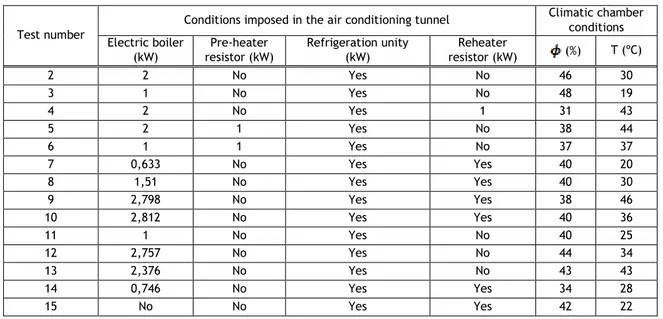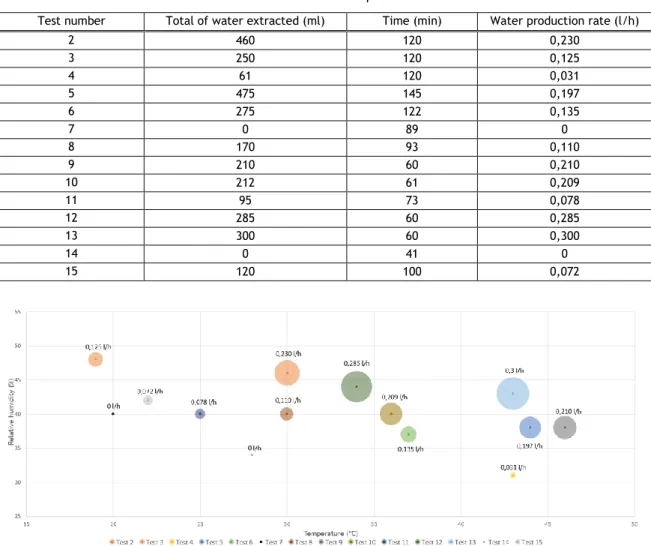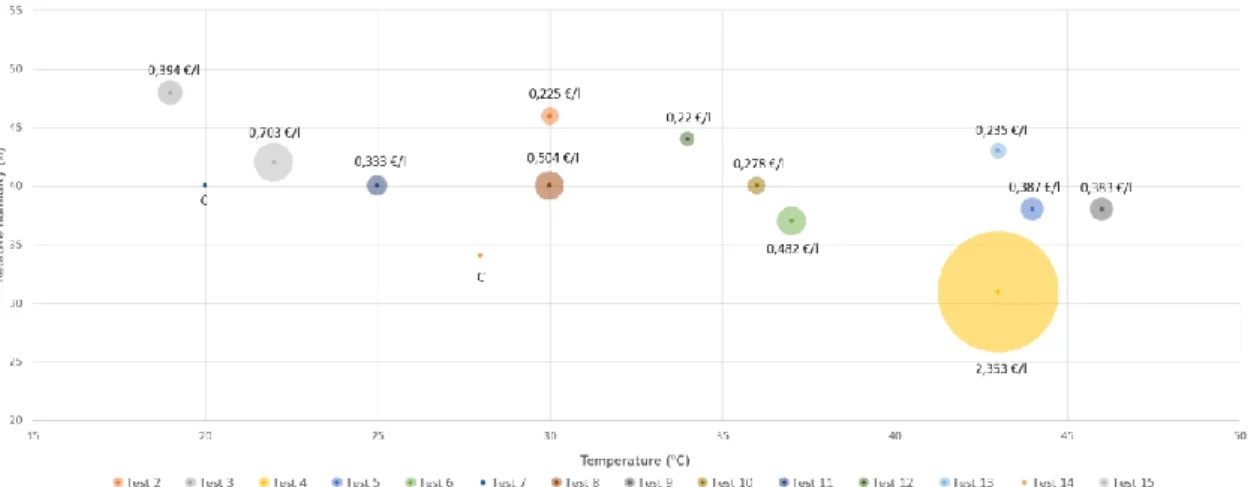Experimental evaluation of water production from atmospheric air by
vapour compression refrigeration
Rui Miranda - ruipedromiranda198@hotmail.com Engineering Faculty, University of Beira Interior
Luís Pires - pires@ubi.pt
Engineering Faculty, University of Beira Interior Pedro D. Silva - dinho@ubi.pt Engineering Faculty, University of Beira Interior
Abstract
The problem of water scarcity is nowadays one of the themes under discussion around the world. Currently arise increasingly prevention measures, as well as have been developed and improved systems of production, treatment and storage of water. Based on this serious problem lived by a considerable part of the world's population, the present work proposes the use of a simple dehumidification system to obtain water from a renewable source of water, the Earth's atmosphere. Results will be presented concerning the capacity and costs of this type of equipment to produce water. Although the extracted water, from the atmospheric air by condensation of water vapour, in vapour compression refrigeration systems, require treatment and to be mineralized, this equipment can be used in any house as a source of drinking water. The work includes conducting experimental studies, in a climatic test chamber, using a commercial equipment with a dehumidifying capacity of 20 l/day, for values of 30 ºC and 80% of relative humidity and temperature, respectively. This equipment has an operating range of 5-32 ºC for the temperature and 30-90% for the relative humidity. The tests were realized with The largest production of water occurred for ambient conditions, inside the climate chamber of 43 ºC and 43%, temperature and relative humidity, respectively, being obtained 0,3 l/h
Keywords
Experimental evaluation of water production
from atmospheric air by vapor compression
refrigeration
I. Introduction
Potable water crisis is a deniable world concern of the last years. To control the use of this resource a lot of studies and international conferences have been made. Moreover, researchers from all over the world have developed different technologies for water supply. Several researchers propose that the lack of water isn’t a problem of water scarcity but, otherwise, it is caused by a poor management of this resource. They suggest that if the water resources were well distributed in the planet, we shouldn’t notice de lack of water. Other researchers defend that water problem results from hydrological variability and high human use. The decrease of the amount of water capable of being used by mankind can affect the world economy, limiting economic growth and job creation. The main risk of lack of water is the deterioration of human health.
But how can’t exist water for human use, if the surface of the planet earth is consisting of 2/3 of water? Nevertheless, only 3% is potable water. And only 23% of these 3% are available to mankind [1]. The water vapor in the earth’s atmosphere represent only 0,001% of the total quantity of the water in the planet [2]. This amount of water vapor may seem quite few but this small reservoir of water can be very important, once it can be considered renewable. This statement is corroborated by the hydrologic cycle. The water cycle constantly provides and removes water from the atmosphere in a natural way.
To counteract the evolution of this serious problem, several researchers studied different ways to produce water from atmospheric air. This solution is known as atmospheric water vapor processor (AWVP). The AWVP solution can be divided in three classes of technologies. The solution either cool a surface below the dew point of the ambient air, concentrate water vapor through use of solid or liquid desiccants, or induce and control convection in a tower structure [3]. Despite the existence of these three possibilities will only one will be discussed in this article, the one in which a surface is cooled below the dew point, more properly using a vapor compression heat pump.
The vapor compression refrigeration to produce water from atmospheric air was discussed, for the first time, in 1969, when E. Reinius edit an experimental report, developed by B. Hellstrom, which is published after the author’s death. This report probably represents the first attempt to produce water from atmospheric air in order to be drinkable. After this publication almost all published articles were related with changes in the system configuration. Wahlgren conducted a thorough description of the atmospheric water vapor processor technology [4]. In the same study he also did conduct the comparison of this technology with other existing technologies for water production. Different authors developed a report where performance of a two-stage heat pump was tested. This change made in the system represent an increase in heat recovery at 35%, compared with a normal heat pump [5]. Habeelullah studied the influence of air velocity to the evaporator inlet. He concluded that if the air velocity is very high, the dehumidification capacity decreases. On the other hand, if the air velocity is too low ice will be formed on the evaporator fins, decreasing the dehumidification capacity [6]. One of the most promising change in the conventional heat pump system for this purpose consisted to force the water vapor to separate from the atmospheric air. After this stage, the refrigeration system only has to cool vapor, requiring less energy than if it had to cool the entire mass of air. To realize de separation a selective membrane was used [7].
All of this researchers, that have been studied this technology, agree that the extracted water should pass a treatment process before consumption. To realize this treatment several technologies can be considered, being divided into technologies with the use of membranes and technologies that perform water treatment based on other processes, like pure mechanical, chemical or thermal. For technologies that use membranes to turn water drinkable, the treatment processes can be realized with pressure, thermally and osmotically.
II. Experimental Setup
A. Description of the equipment used in experimental setup
To realize the experimental evaluation of the capability of the compression refrigeration system to produce water from atmospheric air, it was used a commercial dehumidification heat pump. This equipment was developed by TROTEC and it is suitable for industrial dehumidification processes. Its main characteristics can be seen in table 1 [8].
Through the process of vapor compression this equipment assures an automatic decrease of the humidity in any closed space. According with the developer company, the TTK 75 Eco allows a reduction of up to 30%, and an increase on the temperature of 1-3 ºC.
Table 1- Main characteristics of TTK 75 Eco equipment, by TROTEC [8]
Parameter Value
Model TTK 75 Eco
Dehumidification performance (at T=30 ºC and =80%) 20 l (at T=20 ºC and =60%) 6,4 l Operating conditions T=5-32 ºC with =30-90%
Max. power input 0,44 kW
Refrigerant R134a
Air flow rate 260 m3/h
In order to generate several different environmental test conditions an air-conditioning laboratory unit, developed by P.A. Hilton Ltd, was used. This equipment provided air to the interior of a climatic chamber where the dehumidification unit was placed. The outlet air of the climatic chamber was either reinjected in the air conditioning unit or discharged into the laboratory facilities where the tests took place.
The scheme of the air conditioning unit can be seen in the figure 1. Number 1 identifies the fan of the unit and numbers 2 and 4 represents the electric heating resistors. Number 3 identifies the cooling unit for air cooling and dehumidifying and number 5 represents de electric boiler. The control panel is represented by the number 6 and the number 7 identifies the local of measuring temperature and humidity of air. A temperature controller and a power regulator may also be added to the air-condition unit. The temperature controller is connected to one electric heating resistor and the power regulator can be connected to the electric boiler.
The climatic chamber used for the experimental tests was located in the Applied Thermodynamics and Heat Transmission Laboratory of the Beira Interior University. Details of the chamber composition and construction can be found in Pires, 2010 [9]. The dimensions of chamber are represented in figure 2.
Figure 2 - Dimensions of the chamber used [9]
The chamber walls are made with water repellent MDF and extruded polystyrene, with 19 and 55 mm of thickness, respectively. The final thickness of the walls is 188 mm and this is formed by 3 plates of extruded polystyrene and 2 of water repellent MDF, as can be seen in figure 3.
Figure 3 - Composition of the walls of the climatic chamber [9]
B. Performing processes of experimental tests
To obtain a significant range of test conditions different air-conditioning unit set conditions were used, has is presented in figure 4. These set conditions can be distinguished from each other due to the air circuit configuration and the use or not of additional regulators. For the characterization of the tests it was necessary the measurement and recording of temperature and humidity values. The measurement of these values took place inside the tunnel of the air conditioning unit, in the outside environment and inside the climatic chamber. Table 2 presents, for the tests realized, the conditions imposed in the air conditioning tunnel and the obtained conditions inside the climatic chamber.
Table 2 - Realized tests, conditions imposed in the air conditioning tunnel, checked conditions and the results Test number
Conditions imposed in the air conditioning tunnel Climatic chamber conditions Electric boiler (kW) Pre-heater resistor (kW) Refrigeration unity (kW) Reheater resistor (kW) (%) T (ºC) 2 2 No Yes No 46 30 3 1 No Yes No 48 19 4 2 No Yes 1 31 43 5 2 1 Yes No 38 44 6 1 1 Yes No 37 37 7 0,633 No Yes Yes 40 20 8 1,51 No Yes Yes 40 30 9 2,798 No Yes Yes 38 46 10 2,812 No Yes Yes 40 36 11 1 No Yes No 40 25 12 2,757 No Yes No 44 34 13 2,376 No Yes No 43 43 14 0,746 No Yes Yes 34 28 15 No No Yes Yes 42 22
Figure 4 - Air circuit configuration from each processes used
III. Results and Discussion
As described above, the objective of this work was to evaluate the water production capabilities of the dehumidification unit in different tests conditions, described above. For that evaluation it was considered the amount of water obtained in each test and the correspondent energy used.
A. Amount of water extracted
In table 3 it can be seen the results of the extracted water rate. The water extraction data collection began only after steady state condition in climatic chamber.
As result of the observation of table 3 and figure 5, it was concluded that:
• For the same relative humidity, higher temperature values will result in a higher water production, as can be seen in tests 11 and 15.
• Fixing the value of the temperature and increasing the amount of relative humidity on the air inside de chamber, greater is the production of water. As can be seen in tests 2 and 8, where the production increase to double. Considering test 4 and 13, the production increased ten times.
• Fixing the value of the relative humidity and increasing the temperature inside the chamber increases the water production. As can be seen in the tests 8 and 11, where the amount of water per unit of time increase 6%/ºC. For the tests 8 and 10, the amount of water per unit of time increase 8%/ºC.
Table 3 - Extracted water and production rate
Test number Total of water extracted (ml) Time (min) Water production rate (l/h)
2 460 120 0,230 3 250 120 0,125 4 61 120 0,031 5 475 145 0,197 6 275 122 0,135 7 0 89 0 8 170 93 0,110 9 210 60 0,210 10 212 61 0,209 11 95 73 0,078 12 285 60 0,285 13 300 60 0,300 14 0 41 0 15 120 100 0,072
Figure 5 - Water production rate for different test conditions
B. Average electric power
Average electric power was calculated by measuring the electric energy consumed in the period of each test. The analysis of the obtained values allows us to evaluate the cost of liter of water produced. As result of the observation of table 4 and figure 6, it was concluded that: • When two test are realized with the same temperature, the power used is about the same. As can be seen in tests 4 and 13.
• The limit of 0,44 kW indicated by the manufacturer, for this equipment, was outdated in several tests. This occur only in tests where the temperature inside the chamber is bigger than the limit imposed by the manufacturer. For this conditions the use of the unit is not recommended.
Table 4 – Average electric power in each test
Energy (kWh) Time (min) Average power (kW)
2 0,752 120 0,376 3 0,631 120 0,316 4 0,920 120 0,460 5 1,179 145 0,488 6 0,849 122 0,418 7 0,109 89 0,073 8 0,549 93 0,354 9 0,515 60 0,515 10 0,378 61 0,372 11 0,203 73 0,167 12 0,402 60 0,402 13 0,452 60 0,452 14 0,111 41 0,162 15 0,541 100 0,325
Figure 6 – Average electric power
C. Electric energy and money cost per liter of water
The cost per kWh of energy in Portugal is about 0,156 €. The values obtainment for energy were directly measured with an energy monitor. Knowing the amount of energy used in each test it is possible to obtain the cost of one liter of water.
As result of the observation of table 5 and the figures 7 and 8, we can conclude that:
• Fixing the temperature and decreasing the relative humidity increases the energy consumption. As can be seen in the test 4 and 13, where the energy increased ten times. For the tests 2 and 8 the energy increased to double.
Table 5 - Results of the energy consumption and the cost per liter of water
Test number Total water (ml) Energy (kWh) Energy per liter (kWh/l) Cost (€/l)
2 460 0,752 1,635 0,225 3 250 0,631 2,524 0,394 4 61 0,920 15,082 2,353 5 475 1,179 2,482 0,387 6 275 0,849 3,087 0,482 7 0 0,109 C C 8 170 0,549 3,229 0,504 9 210 0,515 2,452 0,383 10 212 0,378 1,783 0,278 11 95 0,203 2,137 0,333
12 285 0,402 1,411 0,220
13 300 0,452 1,507 0,235
14 0 0,111 C C
15 120 0,541 4,508 0,703
Figure 7 - Energy used per liter of water
The results of energy per liter of water and the cost per liter, for the tests 7 and 14, are represented with the letter C because for these tests the production of water was null. So, these results can’t be quantified, and the energy required to produce one liter of water equal to infinite, as the cost of one liter of water.
Figure 8 – Money costs per liter of water production
IV. Conclusion
The utilization of vapor compression refrigeration systems for water production, unlike the solutions currently in use for potable water production, presents a balance between water availability, production rate, energy consumption and environmental hazards. Environmentally, the use of dehumidification units for water production, allows a decrease of water extraction from natural reserves, decreasing also the used amount of bottled water and piped water. The present study shows clearly that the hygrothermal conditions are preponderant in the performance of water production by atmospheric vapor condensation with compression refrigerants units. When the hygrothermal conditions are favorable, higher temperature and higher humidity, the costs to produce one liter of water are not so unsustainable. Additionally, this solution can be used in combination with solar photovoltaic
to ensure water production in regions with high temperatures, high humidity and plenty solar energy.
References
[1] Nunes, L., et al., “Disponibilidade de água doce no Planeta”, Relatório - Project FEUP, Faculdade de Engenharia da Universidade do Porto, 2009.
[2] Anderson B. T., Chapter 5 - Water in the Atmosphere. 2010.
[3] Wahlgren, R., “Atmospheric water vapour processing”, Waterlines, Vol. 12, N. º 2, pp. 20-22, 1993.
[4] Wahlgren, R., “Atmospheric Water Vapour Processor Designs for Potable Water Production: a Review”, Water Research, Vol. 35, 1-22, 2001.
[5] Chua, K. J., e Chou, S. K., “A modular approach to study the performance of a two-stage heat pump system for drying”, Applied Thermal Engineering 25, 1363–1379, 2005.
[6] Habeebullah, b. A., “Potential use of evaporator coils for water extraction in hot and humid areas”, Desalination, 237, 330–345, 2009.
[7] Bergmair, D., et al., “System analysis of membrane facilitated water generation from air humidity”, Desalination, 339, 26–33, 2014.
[8] TTK 75 Eco, “Manual de instruções”, TROTEC, 2010.
[9] Pires, L., “Desenvolvimento e estudo experimental de uma unidade para o arrefecimento passivo de edifícios”, Universidade da Beira Interior, 2010.
[10] Nandy, A., et al., “A project on Atmospheric water generator with the concept of Peltier effect”, International Journal of Advanced Computer Research, Vol. 4, 481-486, 2014.

![Figure 2 - Dimensions of the chamber used [9]](https://thumb-eu.123doks.com/thumbv2/123dok_br/18650247.912428/4.892.245.645.394.834/figure-dimensions-chamber-used.webp)




